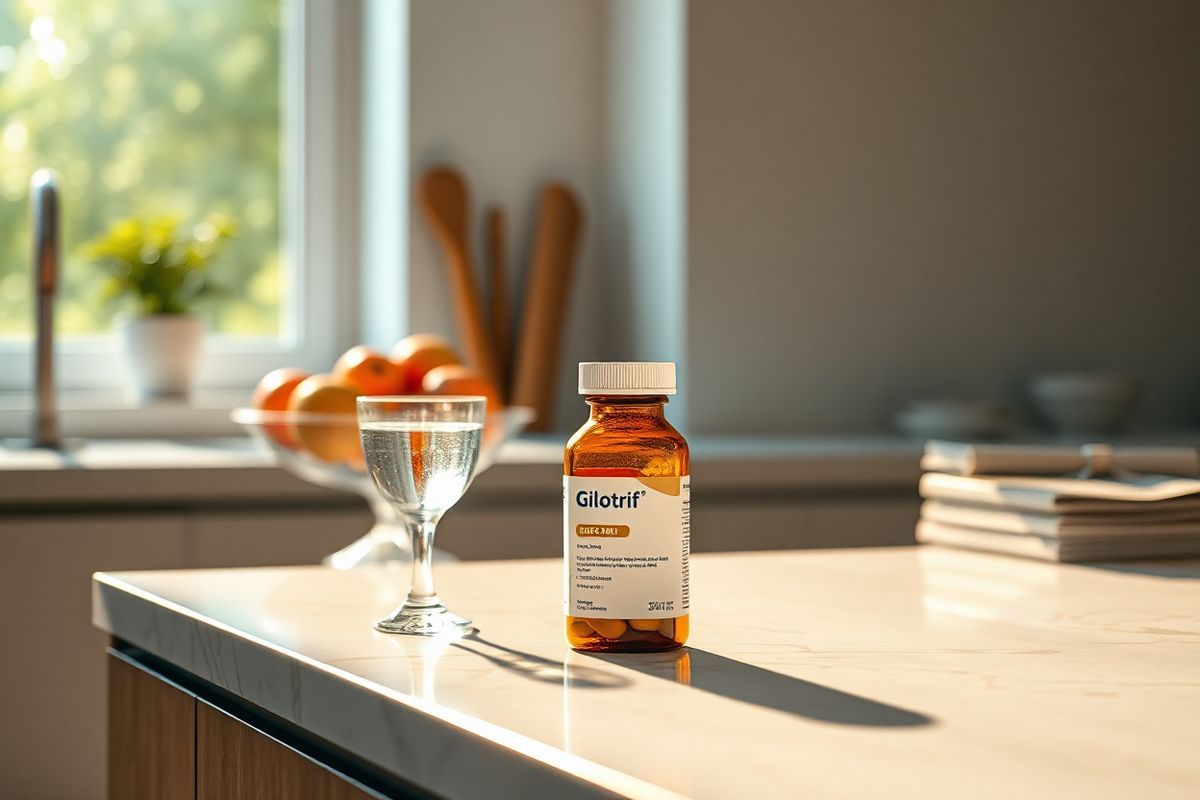Table of Contents
Understanding Gilotrif: What You Need to Know

Gilotrif, known generically as afatinib, is a medication used primarily in the treatment of non-small cell lung cancer (NSCLC). It specifically targets the epidermal growth factor receptor (EGFR), making it a potent option for patients with specific genetic mutations that drive the growth and spread of their cancer. Understanding its mechanism of action is crucial for both patients and healthcare providers to maximize its efficacy and manage potential side effects effectively.
Gilotrif is classified as a tyrosine kinase inhibitor (TKI), which operates by inhibiting the signaling pathways that promote cancer cell proliferation. It is particularly effective in patients whose tumors harbor specific EGFR mutations, including exon 19 deletions and exon 21 L858R substitutions. As with any cancer treatment, it is essential to have a thorough evaluation by a healthcare professional to determine if Gilotrif is the appropriate therapy based on individual genetic profiles and overall health status.
Exploring Dosage Guidelines for Optimal Results

The dosage of Gilotrif is vital for achieving optimal therapeutic effects while minimizing adverse reactions. According to the prescribing information, the recommended starting dose for adults is 40 mg taken once daily. This dosage can be adjusted based on tolerability and the presence of side effects, with some patients requiring dose reductions to 30 mg or 20 mg per day.
TablRecommended Dosage Guidelines for Gilotrif
| Patient Condition | Initial Dose | Possible Adjustments |
|---|---|---|
| Non-small cell lung cancer (NSCLC) | 40 mg once daily | Reduce to 30 mg or 20 mg based on tolerance |
| Renal impairment | Consult healthcare professional for adjustment | N/A |
When taking Gilotrif, it should be administered on an empty stomach, at least one hour before or two hours after eating. This timing helps improve the absorption of the medication and enhances its effectiveness. Consistency in taking the medication at the same time each day is recommended to maintain stable drug levels in the body.
The Strengths of Gilotrif: Benefits and Advantages
Gilotrif offers several advantages, particularly for patients with specific EGFR mutations. Its strength lies in its targeted action, which allows for a potentially more effective treatment with fewer systemic side effects compared to traditional chemotherapy.
One of the notable benefits of Gilotrif is its ability to provide extended progression-free survival in patients with advanced NSCLC. Clinical trials have demonstrated that patients treated with Gilotrif experienced a significant delay in disease progression compared to those receiving standard treatment options. Furthermore, the medication has shown a favorable side effect profile, with fewer occurrences of severe adverse effects commonly seen in chemotherapy, such as neutropenia and gastrointestinal toxicity.
TablComparison of Gilotrif with Standard Chemotherapy
| Feature | Gilotrif (Afatinib) | Standard Chemotherapy |
|---|---|---|
| Targeted Therapy | Yes | No |
| Administration | Oral | IV/Oral |
| Common Side Effects | Diarrhea, rash | Nausea, vomiting, fatigue |
| Efficacy for EGFR Mutations | High | Variable |
| Progression-Free Survival | Extended | Shorter |
Administration Forms of Gilotrif: How to Take It
Gilotrif is available in a tablet form and is taken orally. The tablets should not be chewed, crushed, or split, as doing so may affect the medication’s effectiveness. Patients should swallow the tablets whole with a glass of water to ensure proper absorption.
It is crucial for patients to adhere to the prescribed regimen and inform their healthcare provider about any difficulties in swallowing the tablets or any other issues that may affect compliance. If a dose is missed, patients are advised to take it as soon as they remember, unless it is almost time for the next scheduled dose. In such cases, they should skip the missed dose and resume their regular dosing schedule. Patients should never double up on doses to make up for a missed one.
Timing Your Dose: When is the Best Time to Take Gilotrif?
Timing is an essential aspect of taking Gilotrif to maximize its effectiveness and minimize side effects. As previously mentioned, Gilotrif should be taken on an empty stomach. This requirement means that patients should take their medication either one hour before or two hours after meals.
For many patients, incorporating Gilotrif into their routine can be simplified by selecting a consistent time for administration. Whether it is in the morning or evening, the key is to maintain the same timing each day. This consistency can help establish a habit, making it less likely for patients to forget a dose.
FAQs about Gilotrif Usage
-
What should I do if I miss a dose of Gilotrif? If you miss a dose, take it as soon as you remember. If it is near the time for your next dose, skip the missed dose and continue with your regular schedule. Do not take two doses at once.
-
Can I take Gilotrif with food? It is recommended to take Gilotrif on an empty stomach to enhance absorption. Avoid taking it with food, especially high-fat meals.
-
What are the common side effects of Gilotrif? Common side effects include diarrhea, skin rash, nausea, and mouth sores. Consult your healthcare provider if you experience severe or persistent side effects.
-
How long will I need to take Gilotrif? The duration of treatment with Gilotrif depends on individual circumstances, including the response to treatment and the presence of side effects. Your healthcare provider will determine the appropriate length of therapy.
-
Is Gilotrif suitable for everyone? Gilotrif is specifically indicated for patients with NSCLC who have certain EGFR mutations. A thorough evaluation is necessary to determine if this treatment is appropriate for you.
References
- Dosage versus Dose. (n.d.)
- Chen, J., Cui, W., & Xie, J. (2024). Effect of exercise based on ACSM recommendations on blood pressure and heart rate in hypertensive patients: A systematic review and meta-analysis of randomized controlled trials. Retrieved from https://doi.org/10.1371/journal.pgph.0003743
- Lo, C. K.-F., Schonhofer, C., Mina, N., Masud, S., & Chapman, M. G. (2024). Erysipelothrix rhusiopathiae-associated bloodstream infection in a patient with systemic lupus erythematosus: a case report and literature review. Retrieved from https://doi.org/10.1099/acmi.0.000881.v3
- Olmez, S. (2024). Mitigating housing market shocks: an agent-based reinforcement learning approach with implications for real-time decision support. Journal of Simulation, 17(1), 1747-7786. Retrieved from https://pubmed.ncbi.nlm.nih.gov/11649216/










